Entries from November 1, 2018 - November 30, 2018
Euroland / UK money trends signalling sluggish outlook
Euroland / UK money trends have stabilised in recent months, suggesting that economic prospects remain weak but have not deteriorated further.
Euroland GDP rose by 0.2% in the third quarter and PMI survey compiler IHS Markit claims that November flash results released last week are consistent with a fourth-quarter increase of 0.3%. Second-half growth, therefore, may have averaged 0.25% per quarter, below the ECB staff’s September central forecast of 0.4%.
Slower economic growth was signalled by a weakening of monetary trends in late 2017 / early 2018. Six-month growth rates of real narrow and broad money, however, have recovered slightly since March / April, with little change in October – see first chart. Allowing for the usual nine-month lead, a reasonable expectation is that GDP will grow by 0.3% per quarter in the first half of 2019. The previous ECB staff projection was for quarterly growth of 0.5% but this is likely to be scaled back to 0.4% or less in the December update.
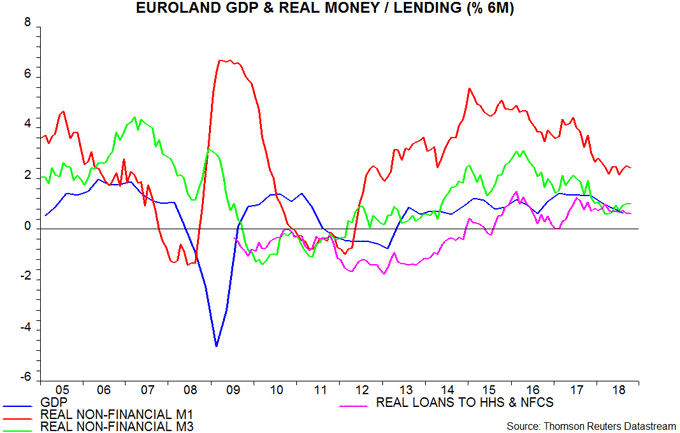
UK real narrow and broad money growth also bottomed in early 2018, recovering into mid-year before slipping back more recently – second chart. Levels are lower than in Euroland. GDP growth of 0.6% in the third quarter was anomalously high and a downshift to 0.3% per quarter or less is plausible over coming quarters.

While six-month growth rates of real money have stabilised, annual growth of nominal narrow money continues to subside in both Euroland and the UK, signalling a likely future slowdown in nominal GDP – third and fourth charts. This prospect suggests that monetary policies should be on hold or shifting to an easing bias. With economic growth undershooting its forecast significantly, and headline inflation about to fall sharply following unexpected oil price weakness, there are strong grounds for the ECB to suspend its previous plan to halt QE at end-2018.

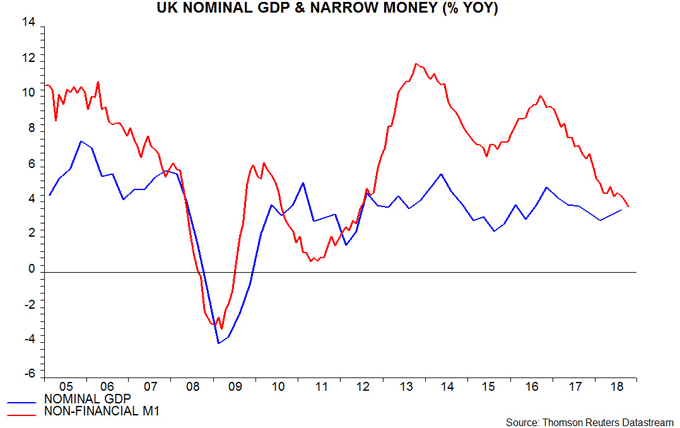
The 2008-09 and 2011-12 Euroland recessions were preceded by a significant divergence of narrow money trends across countries. Reassuringly, no such divergence is yet apparent – fifth chart. Italian real narrow money growth, while below average, has held up better than expected following the rise in yield spreads. The most notable recent development has been a further slowdown in Germany, where real money growth is on a par with Italian – economic prospects may be similarly weak in the two countries.

Chinese money trends still cautionary
Chinese money and credit numbers for October were disappointing, signalling that policy easing has yet to gain traction and may need to be stepped up.
A post last month noted a modest recovery in six-month growth of narrow money and broad credit in September but argued that a further rise would be necessary to warrant shifting away from a negative view of economic prospects. Growth, instead, slipped back in October – see first chart.
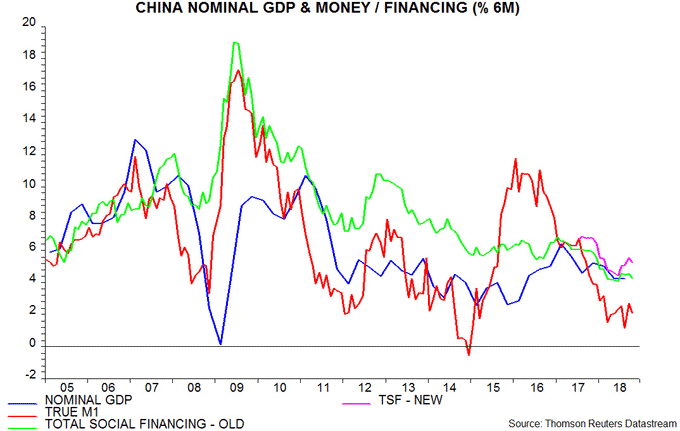
Real-terms money / credit expansion fell to a new low in October as six-month consumer price inflation rose further – second chart. The inflation spike, however, has been driven by food and energy prices, which are now reversing lower – third and fourth charts.
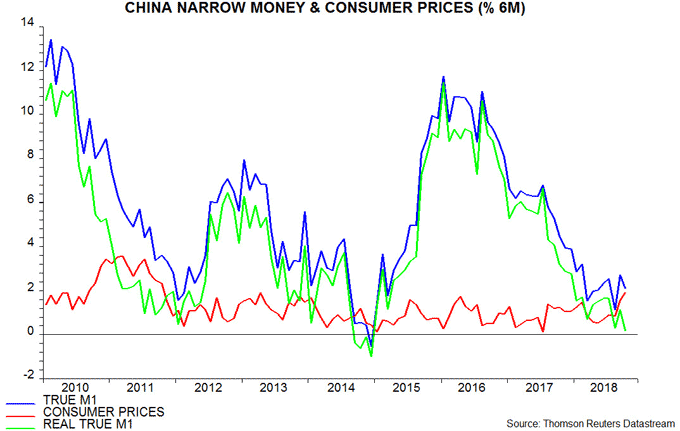

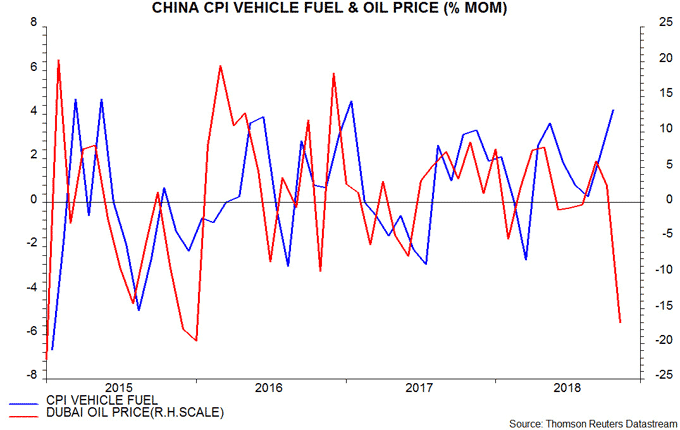
Economic activity is receiving support from a pick-up in infrastructure spending but public sector fixed asset investment is not yet growing strongly – fifth chart. Private investment has remained robust but may lose momentum in response to slowing profits and as housing construction cools - sixth and seventh charts.
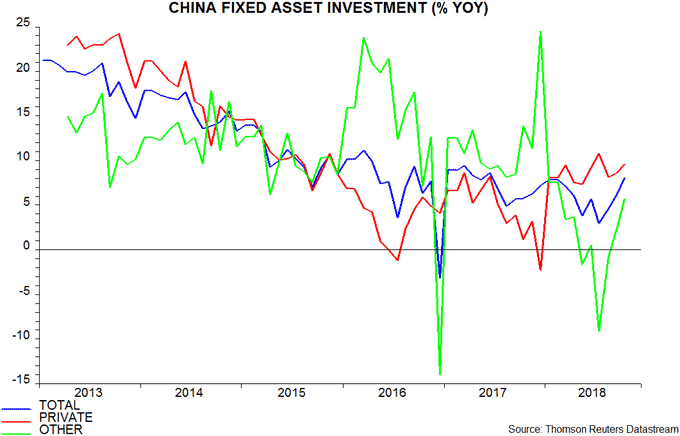
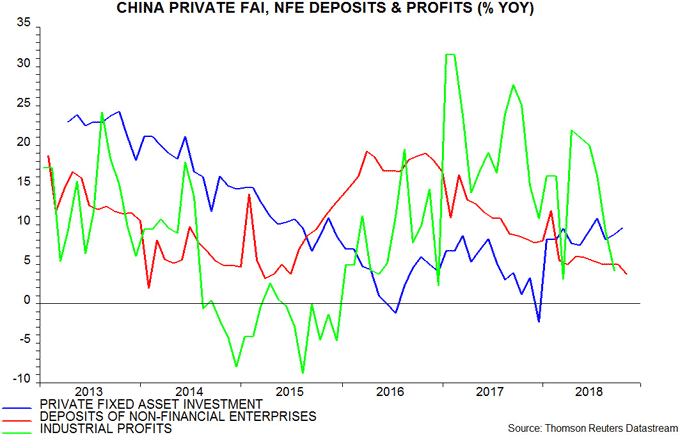

The number of downgrades to company earnings forecasts by equity analysts has risen sharply in November, consistent with a further loss of economic momentum - eighth chart.
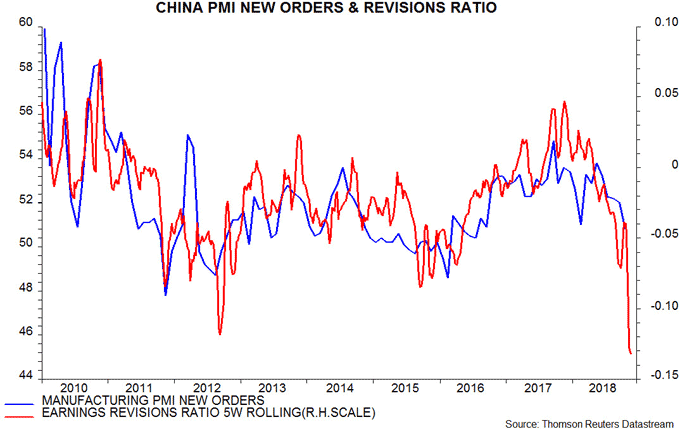
A cautious / negative view of economic prospects will be retained here pending a significant rebound in real narrow money growth. This remains possible: the failure of nominal money trends to recover to date is not inconsistent with historical experience of the policy transmission lag, while further easing is in the pipeline and inflation developments, as noted, should be supportive.
Global monetary update: further weakness
Global real narrow money trends appear to have weakened further in October, suggesting that nine-month-ahead economic prospects are still deteriorating.
Six-month growth of real narrow money in the G7 economies and seven large emerging economies is estimated to have fallen again in October, moving below the previous low reached in February, based on monetary data covering two-thirds of the aggregate and near-complete inflation readings – see first chart. If confirmed, the implication is that six-month industrial output momentum is unlikely to bottom before mid-2019.

Real narrow money growth has fallen below the lows reached in 2011 and 2014, suggesting that the current global economic downswing will be at least as significant as the 2011-12 and 2015-16 slowdowns, associated respectively with the Eurozone crisis / recession and China’s near-hard landing.
Annual growth of G7 plus E7 nominal narrow money has more than halved since 2016 and is approaching the low reached in 2008 – second chart. Annual nominal GDP expansion probably peaked in the second quarter of 2018, with a sustained decline in prospect. This slowdown is likely to squeeze profits and snuff out a recent pick-up in wage pressures. Central bankers worrying about inflationary risks are facing the wrong way.

In contrast to 2008, six-month real money momentum is still comfortably positive because consumer price inflation is significantly lower now than then. A recent pick-up in six-month inflation has contributed to the further fall in real money growth – third chart. This pick-up, however, should unwind as a result of falls in oil and other commodity prices, assuming these are not reversed – fourth chart. Commodity price weakness should be reflected in a sharp decline in prices paid indices in purchasing managers’ surveys – fifth chart.



The further fall in G7 plus E7 six-month real narrow money growth has been driven by the E7 component – sixth chart. A previous post discussed an alarming deterioration in trends across the Far East ex. China / Japan and weakness has now spread to Latin America, with six-month changes in real M1 in Brazil and Mexico turning negative – seventh chart.


Equity analysts are cutting earnings forecasts for EM companies at a faster pace, consistent with a significant economic downturn – eighth chart. The sharp fall in the oil price is similarly suggestive of weakening Asian / EM demand.

US money trends suggesting stable inflation
A post in September 2017 argued that the Fed would become more hawkish as the unemployment rate moved below 4%, partly reflecting concern about a replay of the 1960s, when inflation rose sharply after this level was crossed. A key difference, however, from the 1960s is that broad money trends remain subdued, which may be helping to contain inflation expectations. With the economy expected to slow over coming quarters, an inflation break-out is deemed here to be unlikely.
The earlier post suggested that solid economic growth and 1960s redux concerns would cause the Fed to hike rates by more than the consensus expected in 2018. At the time, the median projection for the three-month Treasury bill rate in the third quarter of 2018 was 1.7%, according to the Philadelphia Fed survey of forecasters. The outturn was 2.1%, with the rate currently at 2.4%.
The first and second charts illustrate the similarity of inflation / unemployment trends in the first half of the 1960s and in recent years. Core inflation remained in a narrow range below 2% despite a multi-year decline in the jobless rate. After the latter moved below 4% in February 1966, however, core inflation surged to more than 3% within a year. In econo-speak, the Phillips curve was flat at unemployment rates above 4% but steepened sharply once this level was crossed.


The unemployment rate fell below 4% in April 2018. While core inflation has firmed, this partly reflects the dropping-out of last year’s large cut in wireless phone charges and a break-out of the range of recent years has yet to occur – September’s 2.0% reading was below a post-recession peak of 2.1% in 2012.
One possible explanation for the difference is that monetary trends have been much weaker than in the 1960s. The third and fourth charts superimpose annual broad money growth, as measured by non-financial M3, derived from data in the Fed’s quarterly financial accounts. Money growth was robust – 8% plus – for several years ahead of the 1966 inflation break-out. It has averaged 5.0% since 2012, recently falling below this level.


High money growth in the 1960s may have contributed to inflation expectations becoming “unanchored”, resulting in a wage / price spiral. Direct measures of inflation expectations, unfortunately, are unavailable for the period but economists’ inflation forecasts rose sharply in 1965-66, which could be indicative of a broader shift – the median one-year ahead projection for CPI inflation increased by 1 percentage point between June 1965 and June 1966, the largest change over 12 months since 1954, according to the Livingston survey (which has a longer history than the Philadelphia Fed survey).
Consumer and market inflation expectations have remained stable recently, as have economists’ forecasts – fifth chart.

Broad money growth fell sharply in 1966, foreshadowing a significant economic slowdown in 1967, which arrested the decline in the unemployment rate and stabilised core inflation temporarily – third chart. Recent weaker money trends – narrow as well as broad – suggest a similar scenario for 2019. The window for a break-out in core inflation, therefore, may be closing. A sustained rise remains plausible over the medium term, assuming that a weaker economy in 2019 leads to easier Fed policy and an associated rebound in money growth.
Global leading indicators signalling further slowdown
Global monetary trends suggest that industrial output momentum will fall further into late 2018, stabilising at a weak level in early 2019 – see previous post. Shorter-term leading indicators are consistent with the forecast of a continued slowdown but have yet to signal a stabilisation.
The forecasting approach here seeks confirmation for monetary signals from a global leading indicator based on the OECD’s country leading indicators*. This indicator typically leads industrial output by four to five months at momentum turning points, compared with about nine months for monetary trends.
The OECD will release September data for its leading indicators on 12 November but most of the component information is already available, allowing an independent calculation.
The OECD presents its indicators in trend-adjusted form, so a rise (fall) signals above (below) trend economic growth. The G7 leading indicator is estimated to have declined further in September, i.e. it continues to suggest sub-par expansion – see first chart.

The rate of decline of the indicator, moreover, has been increasing, consistent with a widening growth shortfall relative to trend.
The global leading indicator calculated here combines data for the G7 and seven large emerging economies and is designed to predict the direction of economic momentum, rather than whether growth is above or below trend. Six- and one-month rates of change of the indicator continued to decline in September, suggesting a further fall in output momentum into early 2019 – second chart.

Assuming that the monetary forecast of a stabilisation of economic momentum in early 2019 is correct, the indicator rates of change should be at or near a low. Until this is confirmed, or monetary trends rebound, a negative view of prospects remains warranted.
*The global leading indicator incorporates the alternative Chinese leading indicator described in a previous post, rather than the OECD’s version.
Brexit-focused MPC ignoring weak money trends
Brexit uncertainty may at least have prevented the Bank of England from making another policy mistake.
Today’s MPC communications suggest that, absent the Brexit cloud overhanging economic prospects, the Committee would have hiked rates again to counter perceived inflationary risks from a tight labour market. Weak money trends, however, argue that policy settings are already restrictive and the next move may have to be to ease not tighten.
Annual growth rates of four different money measures fell further in September, to the lowest levels since 2012 – see first chart*. Consumer price inflation has also declined this year but by much less, so real money growth has slowed significantly.

The second chart compares annual growth of nominal GDP with that of the four money measures. The monetary slowdown since 2016 has been reflected in a slide in nominal GDP growth, ignoring a small recovery in the second quarter of 2018 (which could be revised away). With money trends still weakening, nominal GDP growth may move down further towards 2% in early 2019. The MPC needs to achieve average growth of about 3.5% per annum to meet the 2% inflation target, assuming potential output expansion of about 1.5% pa.

The monetary slowdown partly reflects policy tightening – the November 2017 / August 2018 rate hikes, closure of the term funding scheme in February 2018 and instructions to banks to conserve capital because of Brexit risk. In addition, Brexit uncertainty and slower-than-expected global growth have dampened business / consumer confidence and spending plans, resulting in a reduction in credit demand and lower desired holdings of transactions money.
Facing possibly significant Brexit-related volatility over coming months, the MPC could do worse than steer policy on the basis of monetary trends. That means eschewing any consideration of another rate hike until money growth recovers, and moving to an easing bias if trends continue to weaken.
*Non-financial = held by the household sector and private non-financial corporations. M1 = narrow money = sterling notes / coin and sight deposits. M4 = broad money = M1 plus sterling time deposits, repos and bank securities of up to five years’ original maturity. M4++ = non-official expanded measure = M4 plus foreign currency deposits, national savings and retail sales of unit trusts and OEICs. M4ex = Bank of England’s preferred broad money measure = non-financial M4 plus M4 holdings of financial corporations, excluding intermediaries.

